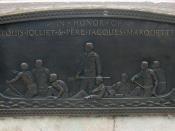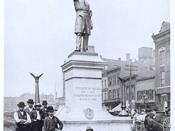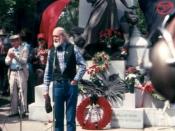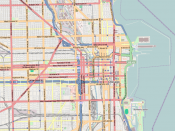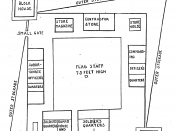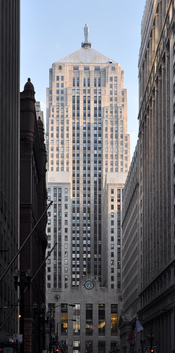History of Chicago June 1, 2001 Chicago is a city rich in history and has had a very eventful past. From it's discovery, to it's integral part in the Civil War, as well as the Haymarket riot and Pullman strike, Chicago is a very interesting city.
Chicago was originally discovered in 1673, by Father Jacques Marquette, a French-born missionary, and Louis Jolliet, a Canadian explorer and mapmaker. Led by Indians, they were the first to pass over the land that is now present day Chicago. Several Indian villages started to appear in later years, around 1696, and a mission was founded there. Little is known about the many years after the mission stopped operating in 1700.
The first settler was Jean-Baptiste Point du Sable, an African American originally from Haiti, who built the first permanent settlement at the mouth of the river in 1779. It was there where the first wedding was performed and the first meeting of the justice department took place.
In 1803, Fort Dearborn was built at the mouth of the river. For many years traders passed through and the garrison inside the fort remained peaceful. But the outbreak of war in 1812 against the British forced the evacuation of the fort. Many of the townspeople left but were attacked by hostile Indians and were massacred. Much of the fort was destroyed, but was rebuilt in 1816. By 1818, Illinois was admitted as a free state and in 1829, the State Legislature laid plans to dig a canal connecting the Mississippi with Chicago.
On August 12, 1833, the town of Chicago was incorporated with a population of 350. The name is thought to be derived from an Indian word meaning "wild onion"ÃÂ or "skunk"ÃÂ, but some believe it means "strong"ÃÂ or "great"ÃÂ. By 1835, the limits of the town were extended, and the population now exceeded 3200 people, and by 1837, it had more than 4200, and was now incorporated as a city. The first elections were held May 2 of that year, and William B. Ogden became the first mayor.
On the 12th day of April, 1861, Fort Sumter was fired on and on the 15th the President issued his first call for seventy-five thousand volunteer troops. Union military successes in the winter of 1865 brought the war to an end in April, but the celebration turned to mourning when on April 15, Abraham Lincoln died by assassination. Also in that year, Chicago's first stockyard opened it's doors, and grew to occupy over a square mile, which fueled Chicago's economy.
But in 1871, a disaster of great magnitude occurred when a fire started to burn out of control on Chicago's West Side. It burned for about a day and a half, and when it was over, 300 were dead and over 90,000 homeless. Chicago quickly rebuilt, and by 1875, little evidence of the disaster remained.
Early in 1886 labor unions were beginning a movement for an eight-hour day. An active group of radicals and anarchists became involved in the campaign and two days later, on May 3, shooting and one death occurred during a riot at the McCormick Harvester plant when police fought with the rioters. On May 4, events got out of control at Haymarket Square where a protest meeting was called to denounce the events of the preceding day. At the meeting, while police were trying to disperse the crowd, a bomb exploded. One officer died almost instantly and seven other officers died later. Eight men were brought to trial and the Judge gave the death sentence on seven of them and the eighth was given fifteen years in prison. Four were hung, one committed suicide and the sentences of two were changed from death to imprisonment for life.
On June 26, 1893, Governor John P. Altgeld pardoned the three who were in the penitentiary.
The sewage system in Chicago was still extremely primitive and many hundreds of people died from diseases ranging from Typhoid to Cholera. In 1887, engineers attempted a bold feat and reverse the Chicago River, to carry the waste Westward through canals. The reversal of the flow was completed in 1900 and the flow was straightened in 1928.
During the height of prohibition and pretty much all through the twenties, mobs and mob bosses such as Al Capone ran the town through bribery and murder. It wasn't until the St.
Valentine's Day Massacre in 1929 that the population took notice to all the mob activity.
Several other events in the 20th century in Chicago were big disasters, like the Eastland disaster, or the McCormick Place fire. Chicago is a city with a rich past and probably an even more eventful future and continues to be one of the most interesting cities in the world.
